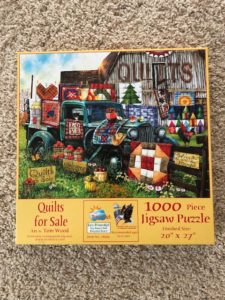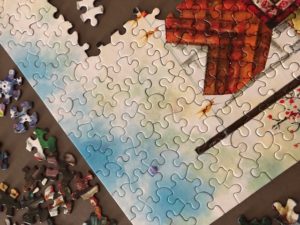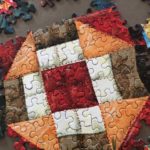I’m still working on my jigsaw puzzle, “Quilts for Sale,” by artist Tom Wood. Writing a mystery is a lot like working a puzzle. I’ve written about the thinking process, research, characters, backstories, and timelines. I’ve also filled in an overall structure and figured out the different areas like introducing the town and characters and bringing in the villains and red herrings. The big picture of my current novel is in my head.
written about the thinking process, research, characters, backstories, and timelines. I’ve also filled in an overall structure and figured out the different areas like introducing the town and characters and bringing in the villains and red herrings. The big picture of my current novel is in my head.
Working on the jigsaw puzzle, I’ve sorted the pieces, created a border which will define the parameters of the puzzle, and arranged some of the pieces into major areas, leaving other pieces to add here and there. Like with my mystery planning, I now have an overall picture and some of the areas of the book in my head. I’ve sorted through this as I’ve worked on the puzzle. Wow, I can still multi-task?
The sorting of pieces and overall structure is done for both the puzzle and the novel. Now, I must fill in areas of the puzzle with similar pieces. This is like writing chapters, coming up with ideas to add details, and rearranging things that I thought would work in a certain spot, but now I find out they won’t. I tend to think of chapters as single scenes or a couple of short scenes.
 In my puzzle, I’m putting areas together that have color patterns that agree. I’m working first on a large part of the puzzle that is a quilt. Then I move into a corner that is sky. It helps my brain to concentrate on a specific area that is one idea—like a quilt or a sign.
In my puzzle, I’m putting areas together that have color patterns that agree. I’m working first on a large part of the puzzle that is a quilt. Then I move into a corner that is sky. It helps my brain to concentrate on a specific area that is one idea—like a quilt or a sign.
Likewise, with my novel I am working on the first 70 pages until there is a major plot point. This is what Jane Cleland recommends in her book, Mastering Suspense, Structure, and Plot. So I am filling in the puzzle from page 1 to page 70. I haven’t written a mystery this way before; I’ve generally outlined the entire book first. However, I’m open to new ideas, so here we go.
By the time the reader gets to approximately page 70 of a 300-page book, several things must happen to set up the major twist, danger, or reversal around page 70. Just as I fill in the pieces of the quilt in my puzzle so they work well together, I must put the pieces of certain book conventions together in the first 70 pages, or so, to lead to that big plot point. I must introduce the protagonist, add her supporting characters, describe the setting, add a little foreshadowing of bad events to come, and begin putting the story in motion to reach that first major plot point. I might add some conflicts, motives, suspects, alibis, and false clues too.
In Three May Keep a Secret, the first major plot point is the death of a former colleague of Grace Kimball’s. That occurs a bit  early on page 45 or so. In Marry in Haste, a banker is murdered in the present day, and I introduce a diary from the 1800s that brings in a second plot. These are right on target around page 70. In Death Takes No Bribes, rumors of cheating on tests at Endurance High School provide a turning point around page 70. In my unpublished novel, A Death at Tippitt Pond, Beth Russell’s house is broken into, and the good-looking detective turns up to find out what happened just at the correct time in the book. Finally, in my current book or work in progress (WIP), a death occurs around page 70. In that last novel, I am currently filling in the puzzle pieces to lead to that murder.
early on page 45 or so. In Marry in Haste, a banker is murdered in the present day, and I introduce a diary from the 1800s that brings in a second plot. These are right on target around page 70. In Death Takes No Bribes, rumors of cheating on tests at Endurance High School provide a turning point around page 70. In my unpublished novel, A Death at Tippitt Pond, Beth Russell’s house is broken into, and the good-looking detective turns up to find out what happened just at the correct time in the book. Finally, in my current book or work in progress (WIP), a death occurs around page 70. In that last novel, I am currently filling in the puzzle pieces to lead to that murder.
Like the puzzle I’m putting together, I’ll finish the quilt area—or the major turning point around page 70—and then I’ll work on another part of the puzzle and write to another major turning point around page 140.
This brings us to what we writers call “the muddle in the middle.” That middle area of the book is where readers either get bored and put the book down, never to read it again, or they become even more interested because of all the incidents popping off the pages. This is where part four of this post will begin.
Tom Wood’s puzzles and others can be found at SunsOut.com

You know Susan, I have always loved all kinds of puzzles, especially jigsaw puzzles. I think this is why I gravitated to cozy and murder mysteries. I think its the challenge of solving puzzles and writing them. When I start a new book I get excited about planning the plot and subplots.
I think you’re absolutely right. It’s the thrill of constructing a solveable puzzle.